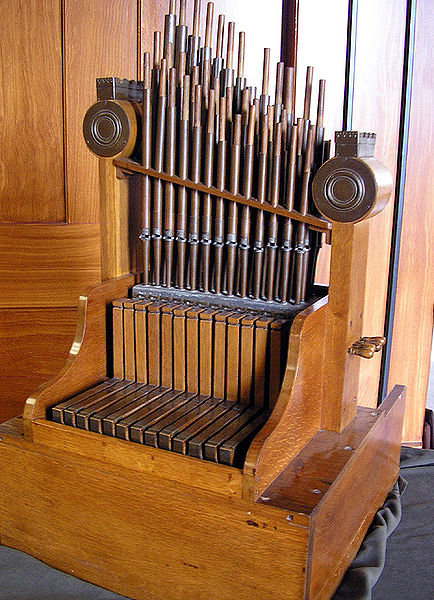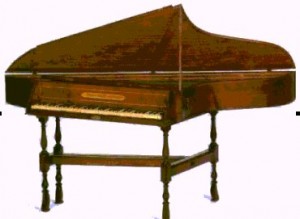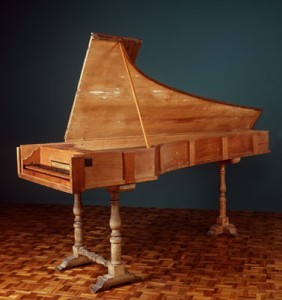A Brief History of the Piano
Perhaps the most ubiquitous musical instrument, after the guitar, is the piano. You see them everywhere. In homes, sometimes in offices, in hotel suites (the really nice, expensive ones), schools—just about everywhere. They come in all shapes and sizes, from a small spinet to a huge 9-foot concert grand, upright, console, grand, electric, digital reproducing. How often have you walked past a piano, and not even noticed it, let alone give any thought to the instrument itself and how it came to be the instrument we know so well?
Let’s take a brief look at the history of this instrument, which is such an important part of western music. The path it took to get to the instrument we know today is a long and interesting one. Time, space, and, quite frankly, scholarship prevent me from bringing you the entire history, but we will look at some of the highlights and milestones in the development of the modern piano.
The earliest musical instruments were drums—of a sort. Somewhere back in Neolithic times, some Cro-Magnon man (maybe even Neanderthal) found that beating a hollow log produced a pleasing sound, and could provide good accompaniment for the dances they did to ensure a good hunt, or whatever it was they needed help with. Of course, I’m speculating here, but it sounds good, doesn’t it?
After the drum, it is thought that the oldest instrument is probably the flute. Through some happy accident, some early man (or woman) found out that blowing across a tube, such as a reed, produced a whistling sound, and that changing the length of the reeds changed the sound of the pitch. The story goes that the demi-god Pan was chasing the nymph Syrinx, and as she fled, she found herself at a lake or pond and could run no further. The gods saw her plight, and to save her from Pan, turned her into a growth of reeds. Pan, coming to the scene, pulled the reeds up and made a flute—the instrument we now call the “Pan-flute” or, in some countries, the “Syrinx.” From that point, things started happening a bit faster. From blowing across the top of a tube, it was discovered that one could create a whistle in the tube, blow INTO the tube, and vary the pitch by putting holes in the tube and closing or opening them. What has this got to do with the piano, you may ask? Well, from that point, it was logical to see if there was some way to work the instrument without having to actually blow in it. Around 200 BC, Ctesibius of Alexandria, and musician and engineer, created the first pipe organ. He called it the “Hydraulis,” and it worked by using water to push air through the pipes. Of course, it only played a few notes, and the “keys” were large—played with the fists, as a matter of fact. Nevertheless, it was the first keyboard instrument.
While the organ grew from its primitive beginnings, string instruments were becoming popular. The earliest being the harp. The early harps had strings strung in a c-shaped bow, and each string tuned to a different pitch. An improvement on that was the Psaltery, which was a harp that was actually on a sounding board, with bridges on the board for each string to change the pitch. It was still plucked with the fingers. It took some time, but eventually, someone figured out a way to pluck the strings mechanically, in much the same way as the organ was played. It was reported that in 1397 a fellow named Herman Poll created what he called the “clavicembalum,” which was actually, the first harpsichord. A mechanism was developed that would allow the player to touch a key, and in so doing, pluck a string. In fact, the term “Toccata,” comes from the Italian word for “touch,” and was originally used to describe any piece played on a keyboard.
Over the next 300 years, the harpsichord developed into one of the most important instruments of music. It was primarily an accompaniment instrument, but grew in popularity as a solo instrument, with more and more important composers writing major solo works for the instrument. Over the years, the size and scope of the instrument changed. Harpsichords were built all over Europe, and each country and each maker added a new dimension to the instrument. Different materials for sounding boards, strings, and cases were used to create a better sound. German harpsichord makes, particularly Gottfried Silberman (1682-1753) added pedals that would change the sonority of the strings, much like changing stops on a organ changes the sound of the instrument, by directing the air to different pipes. In the case of the harpsichord, pressing a pedal might dampen a string, or change over to brass strings, or gut strings, or strings tuned in octaves, etc. Harpsichords were built with two keyboards (manuals) like organs, and some were actually built with a full pedal keyboard, which made it much easier for organists to practice away from the church.
For all the enhancements and advancements that the harpsichord went through, it had one major drawback: no dynamic range. Oh, if you pounded on a key hard enough, it might increase the volume a bit, but it was too hard to do that and still play well. The instrument was pretty much limited to one volume, and that was a problem that harpsichord makers wracked their brains trying to change. A variety of approaches were taken, including the use of a “tangent” (basically, a flat piece of wood, shaved to a point) to strike the string. This method was employed on the Clavichord. With the clavichord, striking a key caused a mechanism to make a tangent strike the string. There were a few problems with this. The clavichord had very little volume, and the string, after being struck, didn’t sustain long, because the tangent was still in contact with it. One interesting advantage of the instrument was that by moving a finger on the key, a player could create a “vibrato” effect on the string, because wiggling the key caused the tangent to wiggle on the string. The instruments were very popular in their day. While this tangent mechanism did provide a bit of a dynamic range, it still wasn’t enough.
The breakthrough came around 1689-90, when Bartolomeo Cristofori (1655-1731) created an instrument he called the “Gravicembalo col piano y forte.” Harpsichrd with soft and loud. The first prototypes were built around 1690, and 3 or Cristofori’s instruments all built around 1722, still survive. The first successful manufacturer of the new “Pianoforte” (a shortened form of Cristofori’s name for his instrument) was Gottfried Silberman, of organ and harpsichord making fame. According to one story, the first time J.S. Bach went to visit his son Carl Philip at the court of King Frederick the Great, Carl showed his dad a couple of the new Silberman Pianofortes. Bach, by all accounts was not impressed, and this really got Silberman hot under the collar. Such was his respect for Bach, however, that he worked on improvements to the instrument, and the second time old JS tried it, he was pleased. Or so the story goes.The mechanism that operates the pianoforte is quite complex, and involves a hammer striking the strings. In Germany, the term “Hammerklavier” was sometimes used to make the distinction between the harpsichord and the new instrument. The big difference between the mechanism for the pianoforte and the clavichord is that when the hammer strikes the string, it does not remain in contact with the string, allowing the string to ring and sustain a note much longer. In creating this mechanism, a damping system had to be developed so that shorter notes could be played. A very complex mechanism, but one that allowed for a dynamic range. The harder or softer one strikes the key, the louder or softer the volume of the note played.
Right up until Haydn’s time, the pianoforte was considered experimental, and the harpsichord remained the primary keyboard instrument (along with the organ) until the mid 1700’s. By the 1760’s improvements to the instrument were such that the harpsichord was becoming old-fashioned, and new virtuosi of this new instrument (by this time, it was no longer considered a “better harpsichord”) began popping up all over the place.
Over the next 150 years, the use of new materials, for sounding boards and strings, and better, more precise keyboard mechanisms, brought the pianoforte (sometimes called the “fortepiano,” particularly in England) to the forefront of musical instruments. In Mozart’s time, the instrument had enough projection that it could stand with an orchestra as a “concertante” instrument. Builders like John Broadwood, James Thom and William Allen, Sebastian Erard, and Henri Pape created innovations that improved the action of the keyboard, the tuning of the instrument, and the general sound. It was Pape who first patented the use of felt for the hammers of the instrument, which is the material in use today. Thom and Allen the metal compensation frame, which maintained tuning by not warping like the old wooden frames. Sebastian Erard’s pianos, favored by Chopin, had the most rapid and smooth action of any at that time. The instrument had become so popular, that everyone wanted a pianoforte, but most middle-class 19th century homes couldn’t accommodate the large instruments. Thus, the uprights, consoles, spinets, and “square pianos,” were developed and became extremely popular.
Steinway & Sons, established in 1853 in New York became the premier piano manufacturer in America, and many consider the Steinway grand the benchmark for pianos.
This look at the history of the piano is woefully incomplete. Numerous works have been written about the history of this great instrument, too numerous to mention here. I will tell you that the history of keyboard instruments (and of instruments in general) is fascinating.
Let’s finish with a story that the great Vladimir Horowitz used to tell. He had attended a performance of Paul Muni in “Inherit the Wind” on Broadway, and was very impressed. He went back stage and left a note for Muni expressing how much he enjoyed the performance. The next day, a messenger delivered a note to Horowitz at his Manhattan apartment from Muni which read, “Mor. Horowitz, I’m so glad you enjoyed my performance last night, but it is nothing compared to what you do at the ‘88’.” Horowitz asked his wife, Wanda, what Muni was talking about. She said he (Muni) must have heard him playing at some club called “88,” to which Horowitz said he never heard of such a place. Wand said, “I don’t know—ask your daughter.” He did, and she, too was mystified, and then asked her father how many keys are on a piano. Horowitz said, “I don’t know—I never counted them!”








